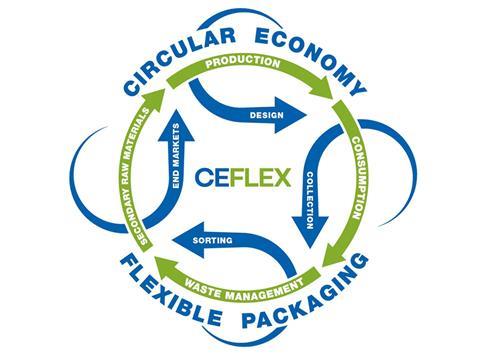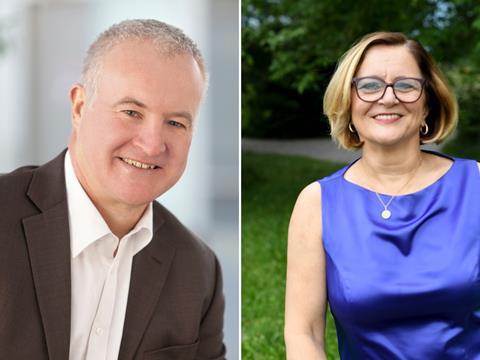
Until now CEFLEX has been working away relatively quietly, with an inward focus on refining its agenda and getting initial workstreams started. Two years into its existence, the collaborative initiative is ready to start communicating its direction of travel to the wider world. Packaging Europe’s Tim Sykes was privileged to be the first journalist invited to attend a CEFLEX general meeting – and came away deeply impressed.
Let’s start with a recap. Launched in 2017, CEFLEX is a pan-European flexible packaging value chain consortium set up with the aim, no less, of facilitating the creation of a practically and economically viable circular economy in flexible packaging. The new idea in the CEFLEX approach is to unite the whole value chain – from chemical companies and converters through to brand owners and recyclers in an endeavour that would be unthinkable without joined-up thinking and complementary action. Dedicated consultants, led by Graham Houlder, oversee a comprehensive programme of seven workstreams, covering everything from design for recycling, sustainable end markets for PCR, to business cases, facilitation of new technologies, and so on. Knowledge is gathered and fed into workstreams from collaborations and commissioned research. And, crucially, the stakeholders play an active role, not least in scrutinising and refining the agenda as it progresses.
Invited to the Q1 2019 stakeholder meeting, I was treated to a vivid insight into this stakeholder engagement. It was rather a thrilling sight to witness some 160 stakeholders come together, brushing aside industry silos and competitive pressures for profound and practical discussions focused on a common goal: to construct the roadmap toward 100 per cent collection of flexible packaging with 80 per cent returning to the circular economy in Europe by 2025.
Constructive, forensic
While the full session of the meeting communicated all the headline news, the day’s real revelation came from the subsequent break-out meetings. Here, working groups representing each of the individual links in the value chain (brand owners gathering in one corner, converters in the next) gathered to frankly talk through the practical implications of the minutiae of the unfolding masterplan for their industry. I won’t report on the content of the conversations upon which I was permitted to eavesdrop. However, I can testify that each group saw lively and forensic discussion between competitors of the little questions arising from the agenda – from “how exactly do we define ‘monomaterial’?” to “what would be the market implications of relaxing optical specifications?” This, above all, is what suggests to me that CEFLEX will succeed. Grand schemes, simple in their basic architecture, only do so when they pay due attention to the complexity of the world they intend to change.
Nevertheless, how is the big picture shaping up?
CEFLEX has set out four essential conditions for building a circular economy for flexible packaging. First, all flexibles need to be collected separately from general household waste. Secondly, monomaterials (which already constitute about 80 per cent of the market) need to be sorted out into clean streams for recycling. One might observe that this 80 per cent of substrate that’s not technologically challenging to recycle represents rather a lot of low-hanging fruit. Thirdly, where possible multi-material flexible packaging (the remaining 20 per cent – or 750 thousand tons) should be redesigned as monomaterials offering the same or acceptable quality. Meanwhile, capability to sort and recycle the remaining multi-material fractions needs to be developed. Fourthly, and essential to the success of the plan, sustainable end markets for PCR must be developed.
There are substantial challenges in each of these objectives. Let’s examine the direction that the respective CEFLEX workstreams are heading in as it seeks to meet them.

D4ACE – design for a circular economy
CEFLEX will submit D4ACE guidelines to consultation in June with the aim of publishing them for Europe-wide implementation in Q3 this year. At this stage the focus has been on setting out the types of flexible packaging that are designed for recycling – i.e. can be sorted and mechanically recycled using existing industrial scale technologies and processes (based on either trial data or existing commercial practices).
The next phase will focus on the more problematic categories of flexible packaging that aren’t widely sorted or mechanically recycled. This will encompass testing and suggested design changes, and it’s envisaged that some structures will ultimately be deemed not ‘designed for recycling’. It will be important to ensure that these do not disrupt the wider sorting-recycling, which means that methods will need to be developed to easily identify and separate them.
Recycling multimaterials
Meanwhile, CEFLEX is actively scouting technologies that can make push the boundaries in not-yet-recycled materials. It is engaging with technology providers for delamination technologies with deinking, such as Cadel Deinking, or without deinking like Saperatec, as well as solvent separation, so called solvolysis, as currently implemented by the Newcyclingâ technology developed by APK (one of the stakeholders in CEFLEX).
A related challenge is that of separating particular structures (whether ‘designed for recycling’ or not) post-collection. “Having closely watched the Holy Grail Project, commissioned by the Ellen MacArthur Foundation, we decided to assess digital watermarking technology as an enabler of sorting using devices like a customised camera,” Dana Mosora, CEFLEX workstream consultant told me. As reported in Packaging Europe magazine last year, watermarking technology has already demonstrated considerable promise in its capacity to sort rigid plastic packaging, and trials with flexibles are forthcoming.
Meanwhile, both constraints around food contact applications and the need to replenish quality after multiple cycles of mechanical recycling point in the direction of a significant role for chemical recycling. Frankly, there is still a lot of mapping to be done around how exactly chemical recycling will fit into the landscape, as well as the broader market dynamics for food. “We intend to create the full picture of the flow of waste plastic showing the input and output materials’ minimum requirements for food applications, including available certification,” Dana commented.
End markets
The CEFLEX vision of more than 80 per cent of flexibles being made available to go back into the circular economy relies on the existence of sustainable end markets for more than 2.5mil tons of PCR derived from flexible packaging. Work towards nurturing such markets is focusing on existing, but not yet mainstream, technologies, such as NIR sorting for separation by polymer and by colour, decontamination with hot washing and enhanced filtration and degassing. “We are currently running trials which will showcase what is the maximum quality of recycled polymers that can be delivered by adding the enhanced separation and decontamination steps in the recycling process for flexible packaging,” according to Dana. “Results indicate potential for various non-food film applications with colourless/odourless rPE film grade. Work is in progress for the colour fractions and mix polymers fractions.”

The next, crucial stage in the technical work will consist in optimising recycling processes to attain an economical balance between added cost and higher value of the output polymer. This workstream project expects to culminate in recommending new sorting specifications to deliver a viable quality and quantity of recyclate for identified new end markets. As Graham Houlder reminds the stakeholders, “A circular economy means that we need to find economically and environmentally viable solutions for all flexible packaging placed on the market - not just the easy to recycle formats.”
Another important aspect of the economics of the circular economy is consumer buy-in. What if the big brands and retailers use their direct relationship with consumers, e.g. to encourage them to accept products with reduced transparency, or to regard recycled plastic as a premium worth paying for?
A sound economic case is at the basis of every strand of the initiative. “Because CEFLEX will only recommend technical solutions with a robust business case for investment in implementation, we are working diligently to develop the EcoChain tool for a combined environmental and financial cost of any process,” Dana revealed. “This belongs to the end of a lifecycle of any flexible packaging. Once fully developed and beta tested, this tool will not only help CEFLEX understand and further recommend those technologies and processes which will indeed enable enhanced value of flexible packaging in a circular economy, but it can also be used by the 28 EU country EPR systems to understand the full costs and impacts of recycling flexible packaging in their country and where more investment is needed.”
Everyone is involved
At the end of a most rewarding day my enduring impression was that CEFLEX is dependent above all on collective buy-in. Within the value chain everyone needs to invest: chemical companies in extending the functionality of existing polymers; converters in monopolymer solutions; waste management in new sorting and recycling infrastructure; and brand owners may have to swallow some temporary loss of margin. The onus is also on stakeholders to compromise where necessary. Brand owners, for instance, may have to accept reduced functionality in the short term in some respects as a reasonable price for more PCR. One of the major contributions of CEFLEX is that the critical mass of its stakeholder base and the rigour of its plan provide a strong degree of confidence in the direction of the market and therefore in ROI. Meanwhile, the trust and transparency building among the stakeholders can only fuel the impetus for compromise.
However, the creation of a circular economy is contingent on wider still cooperation. Within the value chain, retailers have an important role to play – and are notable in their under-representation at the CEFLEX table. Success will also be hugely reliant on external stakeholders. Flexible packaging is currently not even collected separately in a third of EU countries. This has to change, and the value chain is not in a position to make it happen unilaterally. Regulators need to work urgently on harmonisation of infrastructure and standards. Society as a whole must come together to build the circular economy. CEFLEX has set us a laudable example to follow.




















